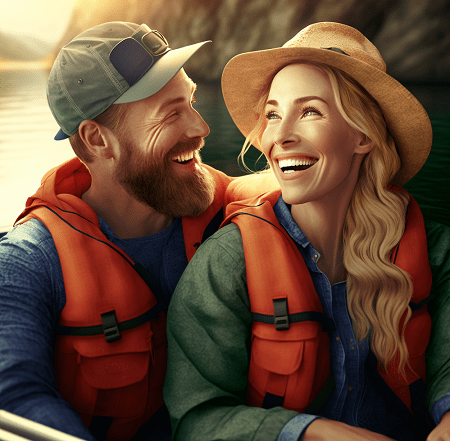As the summer season approaches, many people are looking forward to enjoying the great outdoors on a kayak or canoe. But did you know that according to the U.S. Coast Guard, there were approximately 4,145 reported accidents involving recreational boating in 2018, resulting in approximately 630 deaths? This highlights the importance of being proactive and taking steps to ensure safety while on the water.
Whether you’re a seasoned pro or new to the sport, it’s essential to take the necessary precautions to ensure a safe and enjoyable experience on the water. We have compiled a list of 10 helpful tips for you and your family to keep in mind as you navigate the water. From preparing emergency plans to practicing good hygiene, these helpful pieces of advice will help ensure a smooth and safe return to the kayaking and canoeing:
- Always wear a properly fitting life jacket. Wearing a properly fitting life jacket is the most important safety measure when canoeing or kayaking. It can save your life in case of an emergency and it is also the law. Make sure to choose a life jacket that is appropriate for the activity and fits snugly around your chest, waist and neck.
- Wear appropriate clothing for the weather and water conditions. Dressing appropriately for the weather and water conditions is essential in staying safe while canoeing or kayaking. Wear clothing that will keep you warm and dry, and make sure to bring extra layers in case the weather changes. Avoid cotton as it stays wet and can make you cold.
- Check the weather forecast and water conditions before heading out on the water. Checking the weather forecast and water conditions before heading out on the water can help you to prepare for potential hazards and make sure that you’re dressed appropriately. Strong winds, thunderstorms, and high waves can create dangerous conditions that can make it difficult to control your canoe or kayak.
- Let someone know your plans, including where you’re going and what time you expect to return. Letting someone know your plans, including where you’re going and what time you expect to return, can help to ensure that someone knows your whereabouts in case of an emergency.
- Know your limits and only paddle in areas you’re comfortable with. Knowing your limits and only paddling in areas that you’re comfortable with can help to prevent accidents and ensure a safe and enjoyable experience. If you’re new to canoeing or kayaking, it’s best to start in calm, slow-moving waters and gradually work your way up to more challenging areas.
- Be aware of your surroundings and watch out for potential hazards such as rocks, low-hanging branches, and other boats. Being aware of your surroundings and watching out for potential hazards can help to prevent accidents and ensure a safe and enjoyable experience on the water.
- Keep your canoe or kayak in good working condition by checking for leaks, cracks, or damage before heading out. Regularly inspecting and maintaining your canoe or kayak can help to ensure that it is in good working condition, which can help to prevent accidents and ensure a safe and enjoyable experience on the water.
- Have the necessary safety equipment on board, such as a first aid kit and a means of communication. Having the necessary safety equipment on board, such as a first aid kit and a means of communication, can help to ensure that you’re prepared for emergencies and can get help if needed.
- Learn how to handle common emergencies, such as capsizing or getting lost. Learning how to handle common emergencies can help to ensure that you’re prepared for any situation that may arise and can help to prevent accidents.
- Take a canoeing or kayaking safety course to learn proper technique and safety protocol. Taking a canoeing or kayaking safety course can help to ensure that you have the knowledge and skills necessary to stay safe on the water. It will also teach you the proper technique and safety protocols that you should follow while canoeing or kayaking.
Kayaking and canoeing safety is essential for an enjoyable and safe experience on the water. It’s important to be prepared, aware of the weather and water conditions, let someone know your plans and wear appropriate clothing and life jacket. By following these 10 tips, you can make sure you and your family are safe while kayaking or canoeing and prevent injuries or accidents. Remember that safety is a shared responsibility and with everyone’s cooperation and awareness, we can create a safe kayaking and canoeing environment for all.
Reference:
https://uscgboating.org/library/accident-statistics/Recreational-Boating-Statistics-2018.pdf










